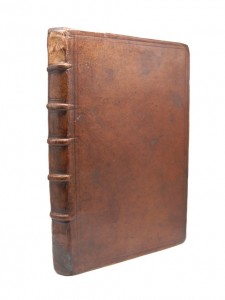
Jonathan Clark Fine Books
Art and Architecture
BABINGTON, John.
Pyrotechnia Or, A Discourse Of Artificiall Fire-Works: In Which The True Grounds Of That Art Are Plainly And Perspicuously Laid Downe: Together with sundry such Motions, both Straight and Circular, performed by the help of Fire, as not to be found in any other Discourse, Extant in any Language. Whereunto is annexed a A short Treatise Of Geometrie.
London, Thomas Harper for Ralph Mab, 1635.
Folio. A fine copy, entirely unsophisticated, with excellent impressions of the plates, crisp and clean, bound in a handsome contemporary calf, the covers bordered with a double blind rule, the spine with raised bands, blind ruled, gilt ruled edges, the stubbs on which the plates are mounted derive from a manuscript legal document, a tear in the lower compartment of the spine with a small loss of leather, neatly repaired, all edges red; pp. [xiv], 72; [iv], 80, 200, (pi1, [fleuron] , A-F , chi², A-F , G , (a)-(c) , (D)-(E) , (f) , (G) , (h) , (I) , K-L , M , N-R . Roman letter, some Italic), fine engraved additional title by Droeshout, with Babington’s portrait in a roundel below, illustrations of his pyrotechnic devices at the sides, letterpress title within double rule with small grotesque woodcut, 18 full-page engraved illustrations, 2 folding engraved plates, woodcut illustrations and diagrams in text, tables, woodcut initials, head and tail-pieces, typographical ornaments; light water stain to the upper blank margin in places, one or two thumb marks, small closed tear in blank gutter of p.6
A fine copy of the first edition of the most important book in the bibliography of fireworks, beautifully illustrated with many fine engravings, by the soldier and mathematician John Babington (baptised 1604, d. after 1635).
This work, which records all we know of the author's life, states that he had been "one of the inferiour gunners of his Majestie", and in the days of peace he had turned his attention from gunnery to fireworks, which were important both for military use and as popular civic entertainment. The major portion of his book sets out, clearly and with illustrations, how to make up the chemicals and structures for each type of firework display (including many still familiar to us today, such as rockets and Catherine wheels). The second part, A Short Treatise on Geometrie, was intended for the use of young mathematical practitioners and especially for gunners. A third section consists of logarithmic tables, possibly the earliest to be published in England in this form (cf ODNB).
The book, the first description of recreational fireworks in English, is dedicated by 'John Babington, Gunner' to his employer the Earl of Newport, Master of King Charles I's Ordnance. "Pyrotechnia, .. was the first English book about how to make recreational fireworks. It was printed in 1635, seven years before the Civil War. Gunpowder had long been used on the battlefield but, in England, it was only during Elizabeth I's reign that this technology developed into something that would create fantastic aerial displays. Elizabeth I was famous for her love of fireworks; sumptuous displays were held in her honour and to celebrate military victories. Pyrotechnia told firework-makers all they needed to know about the chemical compounds and complex structural designs required for firework displays. Babington's instructions are clear, easy to understand and are accompanied by labelled engravings, while the last two sections of the book are helpfully reserved for a treatise on geometry and logarithms respectively. Babington starts simply, with fireworks that are familiar to us today. His is the first printed reference to a roman candle, and there are descriptions of how to make rockets and 'the best sort of starres'. For stars of a blue colour a combination of gunpowder, saltpetre and sulphur-vive did the trick. He then progresses to making "silver and gold raine", firework wheels and "fisgigs", a French firework that fizzed before it exploded. This was all small fry though. Once a firework-maker had mastered the basics, he could recreate the type of spectacle enjoyed by Elizabeth I. One sight in particular was especially popular during this period: the dragon. It consisted of a huge wooden frame stuffed with spinners, fountains, firecrackers and rockets that ignited to give the effect of a huge fire-breathing creature. Often, a second dragon or St George would be pitched against it and a mock battle would take place. In Pyrotechnia, Babington instructs the reader to strap the dragon and St George together so that, when a wheel is turned, "[they] will runne furiously at each other". They had to be well balanced as otherwise "they [would] turn their heeles upward, which would bee a great disgrace to the work and workman". Babington also acknowledges that "much [has been] written upon this same subject", confirming the dragon's popularity. A large proportion of Pyrotechnia is also dedicated to creating fiery spectacles on water, a great skill indeed for any firework-maker. Babington reveals "many workes to be performed on the water", from "how to make a water ball, which shall burn on the water, with great violence" to a "ship of fire workes" and sirens or mermaids "playing on the water"." Maddy Smith, British Library.
Cockle 131; ESTC S106893; Phillip B010.1; STC 1099.
Stock number: 1590
